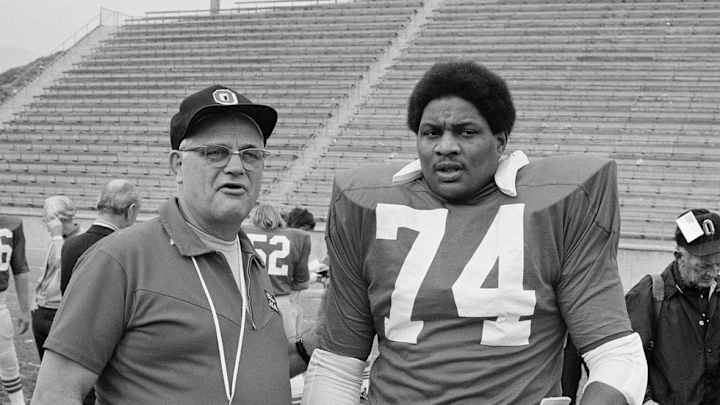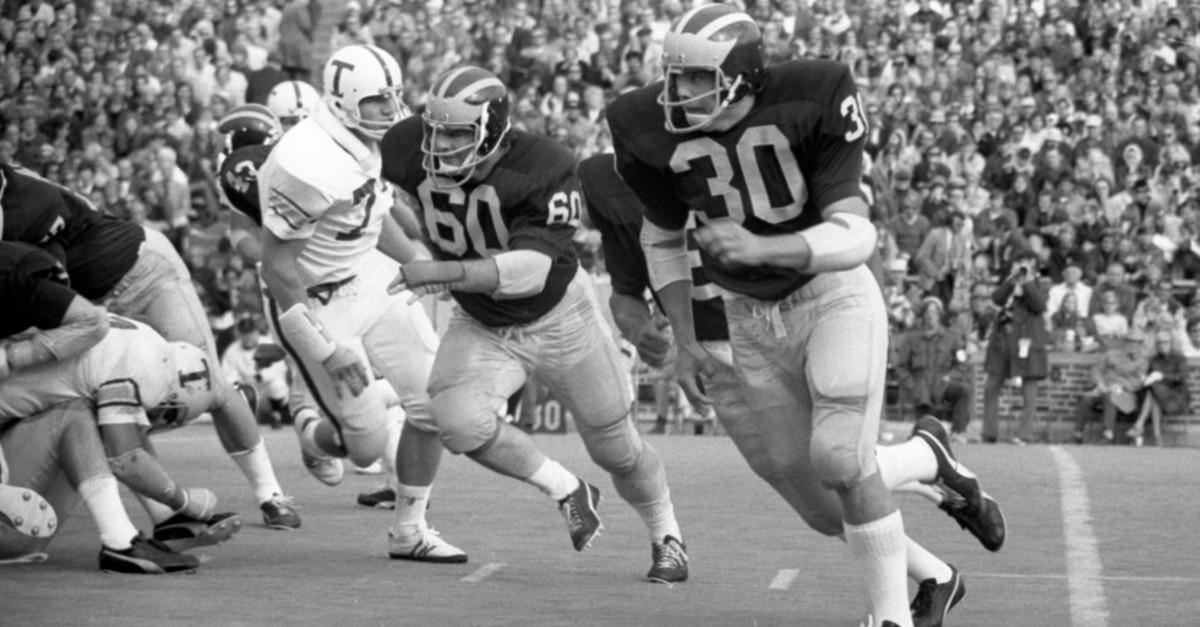From "The Rivalry" Comes A Bond: Michigan's Bob Thornbladh on his friendship with late Ohio State legend John Hicks

[video: 13724714]
Old Michigan football players all have a favorite Bo Schembechler story. Bob Thornbladh, who played and coached under Schembechler, has a favorite Woody Hayes story. He heard it from John Hicks.
It was 1987 and Woody was dying. Hayes had not been Ohio State's head football coach since 1978, but a true coach keeps coaching even after he gets fired. Hayes kept worrying about the players who straggled through life, and he kept pushing the ones who didn't need pushing. You ought to go to law school … Now, the one thing you can't do is feel sorry for yourself … You can't pay back, but you can pay forward.
Hayes called Hicks in to see him. Ohio State fans may remember Hicks as one of the best offensive lineman in college football history—he finished second in the 1973 Heisman balloting. But Hayes also knew Hicks's Ohio State teammates called him The Godfather, because he looked out for everybody. When former Ohio State Jack Tatum battled diabetes and other health problems for years, it was Hicks who took care of him, both physically and financially.
So, like a father talking to his most responsible child, Hayes told Hicks he had to keep his teammates together after Hayes died. "If a Buckeye needs help, you help him," Hayes said. "Or you find a teammate who will."
Then Hayes thought about his former player, Bo Schembechler, and the program Bo had built at That School Up North.
And he told Hicks: If you go somewhere and there aren't Ohio State guys to help, you find a Michigan guy. They're just like us.
* * *
Bob Thornbladh shared a football field with John Hicks a few times in the early 1970s, but he only really met him around a decade ago. It was for a charity event, not surprisingly. Hicks hosted a dinner for the Central Ohio Diabetes Foundation, and through their mutual friend, former Michigan quarterback John Wangler, he asked Thornbladh to speak.
Thornbladh says he went down to Columbus "and did my best to insult them all." He spread the gospel of Michigan's superiority to people who didn't want to hear it. He talked about Hicks and the Buckeyes tearing down Michigan's famous GO BLUE banner before a game and said they should have been arrested.
Hicks loved it. As Wangler says of Hicks: "You spent 10 minutes with him and it's like you'd been friends for life."
Thornbladh and Hicks started calling each other regularly. During football season, they talked every week. When the Big Ten Network produced a documentary about the 1973 tie between Michigan and Ohio State, Hicks said he wouldn't participate unless the producers talked to Thornbladh, too.
There is no recipe for creating a friendship; it either happens or it doesn't. Thornbladh and Hicks did more charity events together, they shared opinions on their alma maters, and they talked about politics and grandchildren and where the country was heading.

Bob Kalmbach/University of Michigan Athletics
But the Godfather's body started breaking down. Kidney failure, diabetes, neuropathy, congestive heart failure. This fall, he came down with an infection and had a toe amputated. He was stuck in the hospital.
Now John Hicks was the one who needed help.
He called Bob Thornbladh every day.
Hicks was a Woody Hayes player all the way: he did not call to complain. He preferred to try to help others. He made plans to host a dinner in Columbus next spring to raise money for schools in Cleveland, Columbus and Detroit.
"He was my contemporary," Thornbladh said, "but he inspired me."
STAPLES: Kansas head coach David Beaty shows the power of patience
On Oct. 22, Ohio State lost to Penn State. Three days later, Thornbladh talked to Hicks. Four days after that, John Hicks died, after 65 years on Earth, 47 as a Buckeye, and the last few as one of Bob Thornbladh's best friends.
"Here is how I feel about John Hicks: He was like Coach Schembechler," Thornbladh said. "My children know all about coach Schembechler because I talk about him. He was important to me. My grandchildren will know about Coach Schembechler.
"Well, my children know about John Hicks. And my grandchildren will know about John Hicks: His values, who he was, what kind of man he was. That's how I feel about him. And I'm not the only one."
When Thornbladh shares John Hicks stories with his family, maybe he will find time for this one:
In the spring of 1969, Michigan assistant coach Jerry Hanlon was supposed to recruit at two adjacent high schools in Cleveland: Cathedral Latin and John Hay. But when Hanlon finished at Cathedral Latin, it was raining outside, and Hanlon, who was exhausted from recruiting all spring, decided not to walk across the parking lot to see John Hay. So Hanlon missed a chance to see John Hay's star lineman: John Hicks.
Perhaps John Hicks's life would have been a lot different if Jerry Hanlon had walked through the rain and lured him to Michigan. But I doubt it.
